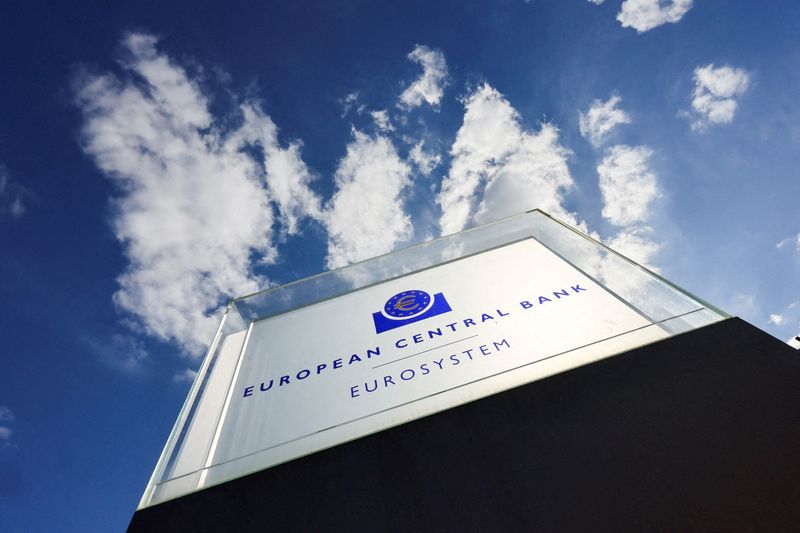Investors tweak bets on ECB rate cuts to the dovish side after Fed, SNB

A view shows the signboard of the European Central Bank (ECB), on the day of the monthly news conference following the ECB’s monetary policy meeting in Frankfurt, Germany, September 14, 2023. REUTERS/Wolfgang Rattay/File Photo
STT
+2.59%
Add to/Remove from Watchlist
Add to Watchlist
Add Position
Position added successfully to:
Please name your holdings portfolio
Type:
BUY
SELL
Date:
Amount:
Price
Point Value:
Leverage:
1:1
1:10
1:25
1:50
1:100
1:200
1:400
1:500
1:1000
Commission:
Create New Watchlist
Create
Create a new holdings portfolio
Add
Create
+ Add another position
Close
CME
+0.72%
Add to/Remove from Watchlist
Add to Watchlist
Add Position
Position added successfully to:
Please name your holdings portfolio
Type:
BUY
SELL
Date:
Amount:
Price
Point Value:
Leverage:
1:1
1:10
1:25
1:50
1:100
1:200
1:400
1:500
1:1000
Commission:
Create New Watchlist
Create
Create a new holdings portfolio
Add
Create
+ Add another position
Close
By Stefano Rebaudo
(Reuters) – Investors tweaked views about the European Central Bank’s policy path to the dovish side on Thursday, and bond yields hit one-week lows after the Federal Reserve indicated 75 basis points of monetary easing in 2024 and the Swiss National Bank cut rates.
The euro zone market reaction to the Bank of England (BoE) was muted while gilt yields extended their fall slightly.
Money markets priced in a 90% chance of an ECB rate cut by June from less than an 80% chance late on Wednesday. They discounted more than 90 bps in 2024 from 85 the day before.
Federal Reserve Chair Jerome Powell said on Wednesday that recent high inflation readings had not changed the underlying “story”. Bank of England Governor Andrew Bailey said Britain’s economy was “moving in the right direction” for the central bank to start easing its policy. The BoE left rates unchanged.
“All in all, the impact of the Fed and the SNB on the euro area is limited,” said Joost van Leenders, senior investment strategist at Van Lanschot Kempen.
Germany’s 10-year government bond yield, the euro area’s benchmark, dropped 4 bps to 2.39%.
The SNB was the first major central bank to dial back tighter monetary policy to tackle inflation. Analysts had expected a first move in June.
“(The) Fed’s expectation for the economic growth in the U.S. questions the possibility of three rate cuts in 2024,” van Leenders added. “However I expect the ECB to be able to ease its monetary policy even if the Fed should hold in June.”
Fed funds futures traders are now pricing in a 66% probability that the Fed will begin cutting rates in June, up from 59% on Tuesday, according to the CME Group’s (NASDAQ:CME) FedWatch Tool.
“The risk to our Fed call of a June start and 125 bps of cumulative cuts are clearly tilted towards a later start and fewer cuts,” said Xiao Cui, senior economist at Pictet Wealth Management. “If inflation fails to moderate in March, that would significantly reduce the odds of near-term policy easing.”
The Swiss 2-year yield, more sensitive to expectations for policy rates, fell 14 bps to 0.98% and was on track for its biggest daily fall since December.
“That should allow for additional rate cuts by late 2024,” said Aaron Hurd, senior portfolio manager at State Street (NYSE:STT) Global Advisors, mentioning global disinflation and a downtrend in Swiss services inflation.
Money markets fully price a cumulative 75 bps of SNB rate cuts by September 2024.
Gilt 2-year yields was down 12 bps at 4.11%; it was at 4.14% before the BoE,
Italy’s 10-year yield fell 5.5 bps to 3.65%.
The gap between Italian and German 10-year yields – a gauge of the risk premium investors ask to hold assets from the euro area’s most indebted countries – was at 125 after hitting 115.4 last week, its lowest in over two years.
Investors closely watched the spreads’ tightening across bond markets as they turned a blind eye to the rising Italian budget deficit and reckoned that a resilient economy would control the country’s critical debt-to-GDP ratio.








